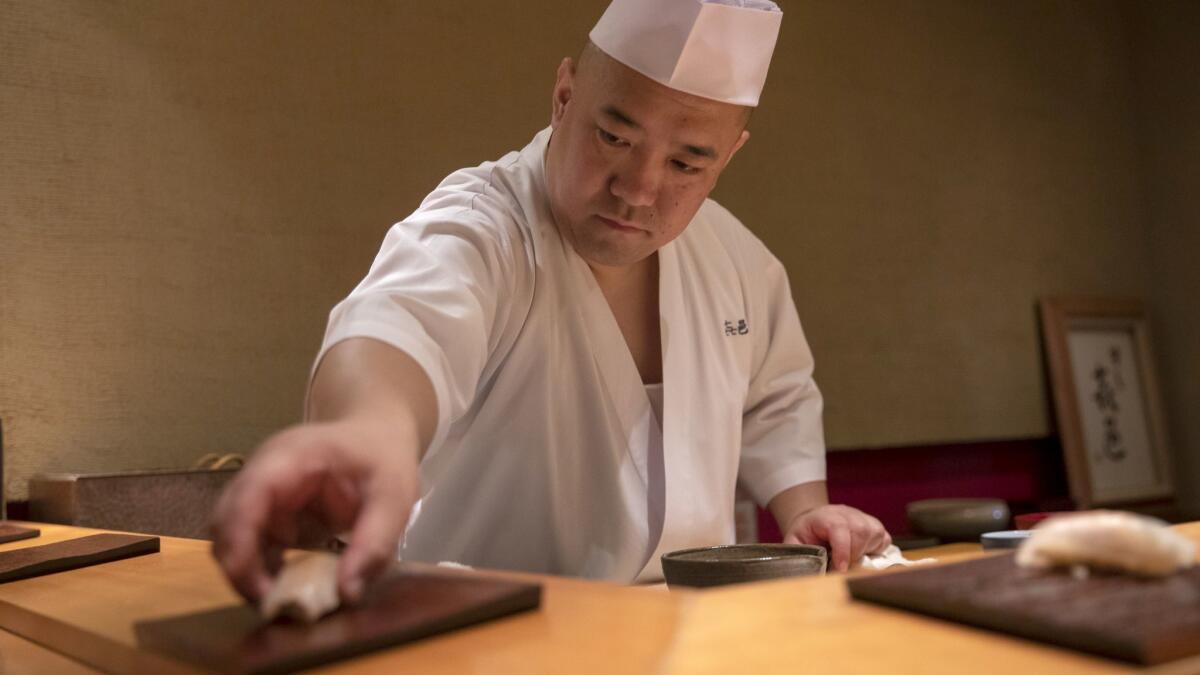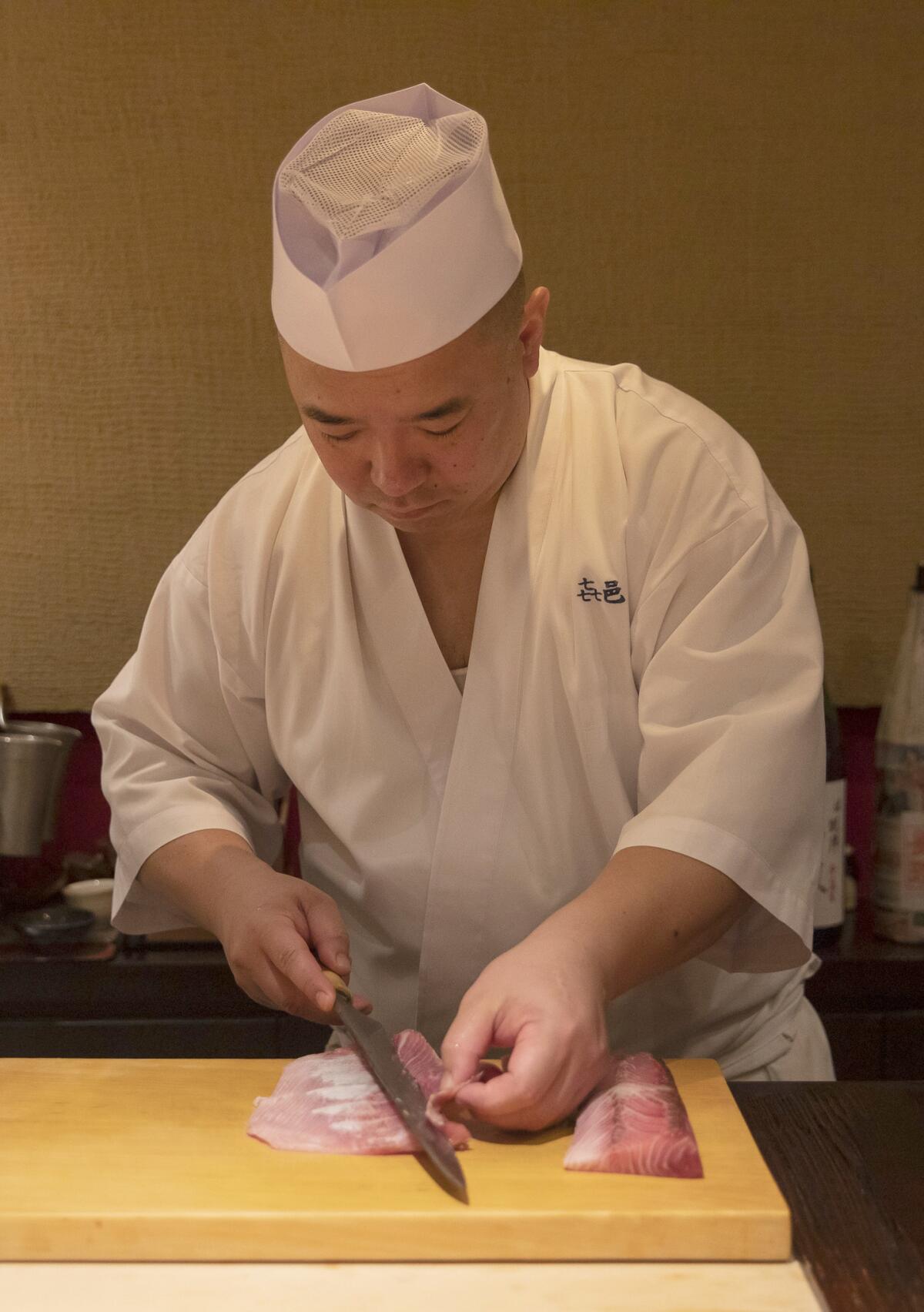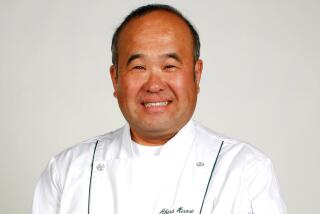How a Tokyo chef makes 54-day-old sushi taste better than the fresh stuff

- Share via
Reporting from Tokyo — The single best thing I ate during a recent trip to Tokyo was a 54-day-old piece of swordfish the color of a smoggy L.A. sunset. It was the final course of an exceptional omakase dinner at Kimura, Koji Kimura’s two-Michelin star, eight-seat restaurant, that consisted mostly of aged fish.
Most sushi connoisseurs prize a pristine surf clam still wriggling when it hits the counter or a sweet shrimp dancing on the plate. There are different levels of freshness when it comes to sushi, including flash-frozen fish that is defrosted before service, and the stuff picked out at the market that morning. But fish that has been sitting in the fridge for weeks before service, that’s a hard sell for most Americans.
You can find some form of preserved or aged fish at Q in downtown L.A., and a couple pieces on menus around the city, but in the States, restaurants pride themselves on letting as little time pass as possible between the boat and your plate. Kimura takes pride in how long he can age his fish before it turns to a mushy pile of rot. You could classify his style of sushi as uniquely his own — a variant on edomae (raw fish with cooked rice seasoned with vinegar).

Kimura’s desire to age fish wasn’t born from an enlightened search for umami, or a desire to find a marketable gimmick. Three years after he opened Kimura in 2005, he was losing money. He was faced with a near-empty dining room night after night, and most of his inventory was ending up in the garbage.
One night, he decided to cut down a large piece of fish that was about to spoil.
“Because there were few customers for a long time, and I had spare time, this fish became spoiled, and since it was big, I thought of cutting it in half to throw it away,” Kimura said. When he peered inside, “I found that the color around the spinal cord was not black, but still alive.”
Kimura scooped out a bit of the meat and was surprised that it was not only edible but also that he liked it.
“It had a taste stronger than the fish’s usual taste,” Kimura said. Wanting to duplicate that intense flavor, he started experimenting. He eventually came up with an aging process that included removing the blood, trimming parts of the fish near the skin that gradually oxidize and controlling the temperature. Where he trims and how much varies from fish to fish, depending on the parts that are exposed to the most air. But Kimura says he tries to keep the fish at a temperature of 1 degree Celsius, or just under 34 degrees Fahrenheit.
His method for deciding how long to age each fish is a little less precise.

“The decision on how many days to ferment is made when I insert the knife into the fish,” Kimura said. “Depending on what the fish grew up eating, what kind of sea it grew up in, the quality of the fish meat when inserting a knife differs completely. And the moment the knife enters, I know instantly whether the length of fermentation should be short or long.”
Kimura has experimented with aging fish for 90 days, but the amount of meat he had to cut away versus the usable parts wasn’t economical. The longest he’s aged a fish for dinner is 60 days.
Kimura, who said he knew he wanted to be a sushi chef when he was in kindergarten, is a jolly host. He smiles while he works, makes two peace signs in photos and will gladly accept a cup of sake between courses.
As a meal at Kimura progresses, so does the age of the fish served. The chef may start dinner with a soup made from boiling down 13 pounds of clams for eight hours. Then comes a sakura (cherry blossom) shrimp paste made with shrimp you can fish only during spring’s cherry blossom season. There’s uni with soba, and then the nigiri begins: aged white squid shaved into translucent ribbons, 6-day-old Kawahagi filefish and its liver, 10-day-old Katsuo bonito smoked with straw and soaked in a mustard soy sauce, a 10-day-old sardine and the 54-day-old swordfish.

There is no fishy odor. Instead, the flavors are bolder than with their fresher counterparts. The umami builds as dinner unfolds — each fish a super-concentrated version of itself — and the texture approaches room temperature butter.
“I believe the recognition that sushi is something that is processed properly is returning,” Kimura said.
To create his flavor bombs, Kimura starts with the freshest ingredients possible, visiting the new Toyosu fish market in Tokyo daily.
“Going to Toyosu every day is the same as a lady going to the department store and buying as many bags as they want,” Kimura said. “There’s no such job as fun as this.”
Kimura will be cooking in Los Angeles in May as part of Food Bowl, The Times’ monthlong food festival. More details can be found at lafoodbowl.com.
Instagram: @Jenn_Harris_
More to Read
Eat your way across L.A.
Get our weekly Tasting Notes newsletter for reviews, news and more.
You may occasionally receive promotional content from the Los Angeles Times.











